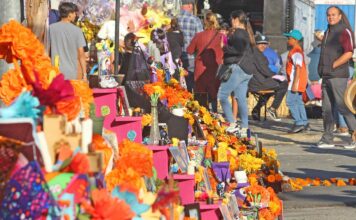Displaying the American flag comes with a whole set of rules
O, say can you see how many South Valley residents are breaking the law by flying their flags improperly? Yes, breaking the law.
U.S. Code, Title 36, Section 10, also called the flag code, details everything from how to raise the flag –if you don’t raise it “briskly”, you’re breaking the law – to when it is displayed–in or near every schoolhouse during school days and in or near every polling place on election days. And though it is one of the only U.S. laws that doesn’t have a penalty for breaking it, that doesn’t mean it should be taken lightly.
The code is long and extremely detailed, but the effusive text serves a purpose.
“We gave it all for our country, and our flag symbolizes that,” said Robert Gonzales, commander of American Legion Post 69 in Hollister and veteran of the Vietnam war. “Flying the flag is practicing freedom of speech. It’s really a symbol of all our freedoms and some of us paid dearly for that freedom. People should fly the colors and people should respect the flag.”
All American citizens should fly the flag, Gonzales said.
“Not enough people fly the flag,” said Wayne Cegelske, commander of Gilroy’s Veteran’s of Foreign Wars Post 6309. “It’s a sign of respect. Even if you don’t like the wars we’re involved in, you’re still supposed to support the troops, support the men and women out there risking their lives 24 hours a day.”
The Gilroy VFW will donate 3×5 flags to anyone who needs a flag to fly.
“If you drive up and down First Street, there are about three different flag poles with nothing on it,” Cegelske said. “What do they have a flag pole sittin’ there for if they’re not going to put anything on it? Even if you don’t fly a flag every day, at least do it on holidays. Let’s get out there and show a little pride and patriotism.”
One of the biggest mistakes people make when they do fly a flag is flying it at half-staff when they shouldn’t, Cegelske said.
“People fly the flag at half-staff when someone like a sports figure dies, but they aren’t supposed to do that,” he said. “A flag should be flown at half-staff only by order of the President of the United States.”
The most basic rules of flying an American flag, according to law, are:
– The flag must never touch the ground, floor or water.
– If a flag flies after sunset, it must be properly illuminated.
– Tattered, defaced, torn or discolored flags should never be flown.
“I noticed one big flag in San Martin that is really tattered and torn,” Cegelske said. “It should come down. After all these rain storms we’ve been having, there are a lot that should come down.”
– No other flag of any kind should be placed above or even at the same level as the American flag anywhere in the United States or its territories.
– The corner part of the flag with the stars, also called the “union”, must be flown at the top and to the observer’s left if the flag is flown vertically.
“The only way a flag should ever be flown vertically off a building, like they did on the Pentagon,” Gonzales said.
– A flag should never be flown upside down, except as a signal of dire distress in instances of extreme danger to life or property.
“If you fly a flag upside down, you’re requesting help,” Cegelske said. “As we’d say in Vietnam, you’re requesting support.”
– The flag should never be used as apparel, bedding or drapery.
“It’s disrespectful to have anything else made out of the flag,” Cegelske said. “It’s so commercialized now, but having clothes made out of the flag is a no-no.”
– When a flag passes by in a parade or in a ceremonial hoisting or lowering of the flag, all present should stand, face the flag and place their right hands over their hearts.
– The proper way to dispose of a flag is to burn it in a somber and patriotic ceremony. The Boy Scouts, VFW and American Legion all accept old flags and practice burning ceremonies in accordance with law to dispose of old flags.
– It is not illegal to burn the flag as a form of protest.











